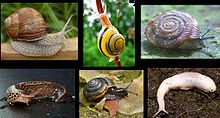Pulmonates
| Pulmonata Temporal range: Carboniferous–recent |
|
|---|---|
 |
|
| Various examples of Pulmonata | |
| Scientific classification | |
| Kingdom: | Animalia |
| Phylum: | Mollusca |
| Class: | Gastropoda |
| Clade: | Heterobranchia |
| Informal group: |
Pulmonata Cuvier, 1814 |
| Taxonomic subdivisions | |
|
|
Pulmonata, or "pulmonates", is an informal group (previously an order, and before that a subclass) of snails and slugs characterized by the ability to breathe air, by virtue of having a pallial lung instead of a gill, or gills. The group includes many land and freshwater families, and several marine families.
The taxon Pulmonata as traditionally defined was found to be polyphyletic in a molecular study per Jörger et al., dating from 2010.
Pulmonata are known from the Carboniferous Period to the present.
Pulmonates have a single atrium and kidney, and a concentrated, symmetrical, nervous system. The mantle cavity is located on the right side of the body, and lacks gills, instead being converted into a vascularised lung. Most species have a shell, but no operculum, although the group does also include several shell-less slugs. Pulmonates are hermaphroditic, and some groups possess love darts.
The taxonomy of this group according to the taxonomy of the Gastropoda (Ponder & Lindberg, 1997) was as follows:
Order Pulmonata Cuvier in Blainville, 1814 - pulmonates
The taxonomy of this group according to the taxonomy of the Gastropoda (Bouchet & Rocroi, 2005) was as follows:
Contains the informal group Basommatophora and the clade Eupulmonata
Contains the clade Hygrophila
Contains the clades Systellommatophora and Stylommatophora
Contains the subclades Elasmognatha, Orthurethra and the informal group Sigmurethra
...
Wikipedia
